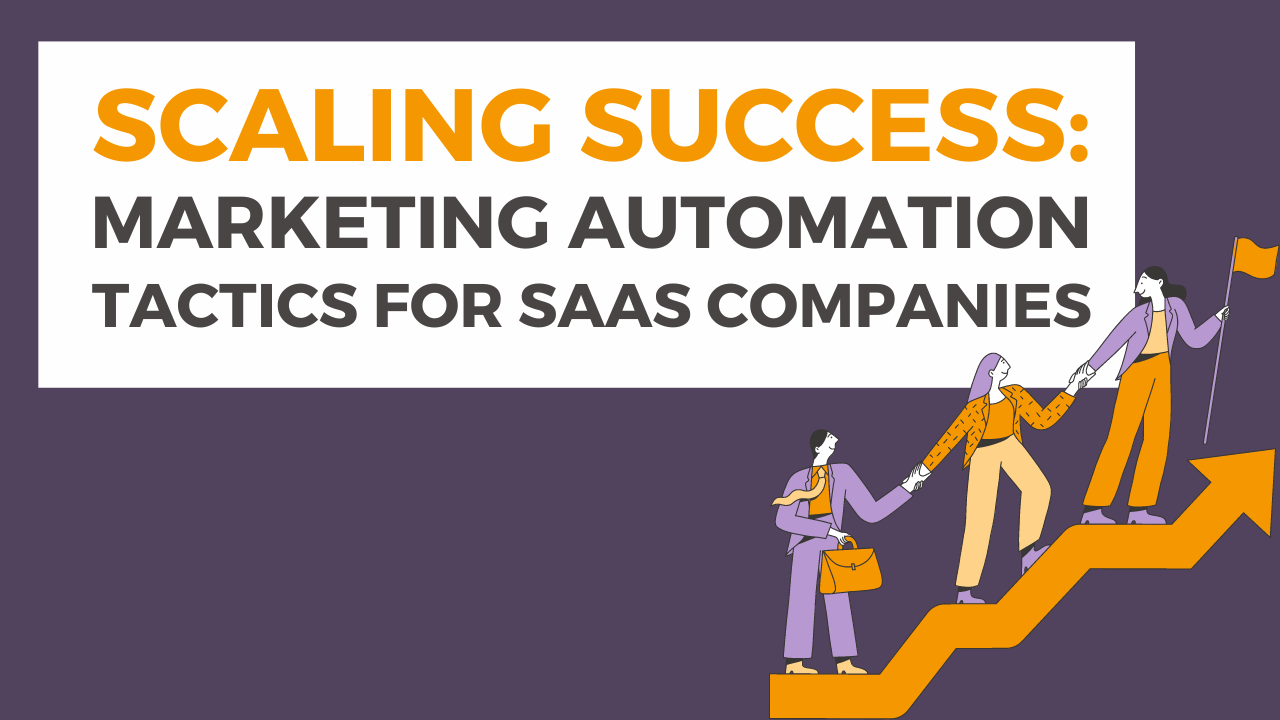Related Articles:
7 B2B SaaS Digital Marketing Strategies To Achieve Success
5 SEO Marketing Strategies for B2B SaaS Companies
Mastering SaaS PPC Advertising: Proven Marketing Strategies
B2B SaaS Content Marketing Strategies: From Ideas to Conversions
B2B SaaS Inbound Marketing: Strategies That Convert
Maximising Reach: 7 Effective SaaS Social Media Strategies
Mastering B2B SaaS Lead Generation: 7 Strategies That Work
Why do you need SaaS marketing automation?
Because you want to tell the world about your SaaS product and the world is a big place with lots of people, all of whom will have varying degrees of knowledge about your product. To sell to them, you’ll need to be able to engage at every stage of the sales funnel — whether they’re barely aware of you or teetering on the brink of buying — to nudge them deeper.
And you’ll need to be able to that in a personal, engaging way.
That takes a lot of time and effort, but it’s time and effort you can minimise when you automate certain parts of your marketing.
Done well, marketing automation can massively increase qualified leads. It can increase sales. It can reduce the cost of winning those sales. It can improve the customer experience by ensuring they see content tailored to their needs, when they need to see it. It can increase customer value, encouraging them to upgrade their package to the next tier. And it can make your life a whole lot less complicated.
But it can only really do that when you understand what SaaS marketing automation is — and what it isn’t.
What SaaS marketing automation isn’t
It’s not a vehicle that enables you to blast a scattergun collection of marketing emails and social ads in the vague direction of potential customers in the hope that something sticks.
True, something might stick. You might just hook a customer or two with a blanket, throw-everything-at-the-wall-and-see-what-happens approach. But you’ll alienate far more people than you attract, and you’ll find many people who could have become valuable users of your SaaS product will have blocked you long before they consider buying.
Nor is automation a marketing strategy in itself. A marketing strategy is your plan to engage a potential audience. Automation is simply a tool to help make doing it easier and more effective. If the marketing strategy doesn’t stand up to scrutiny, automation won’t make it a better strategy.
What SaaS marketing automation is
Marketing automation is doing all the marketing you would have wanted to do even if automation wasn’t an option, only doing it faster and more comprehensively across a much larger field of leads.
Marketing automation can be effective at every stage of the sales funnel. The ‘sales funnel’, just in case you’re new to marketing, is a model that describes the stages of consumer interest and intent.
Consumers start out at the top of the funnel with perhaps a vague awareness of what they need and who you are. They might, for example, have a theoretical knowledge that software could support the stock management of their business. While they are at this early stage of the funnel, your marketing shouldn’t really feel like marketing at all. Instead, it should aim to answer their questions about stock management SaaS software in general and help them address the challenges they face in the business.
Then, as their awareness grows, they slip further down the funnel, shifting from awareness to interest to the point at which they are seriously considering your product. Once they reach this stage, your automated marketing should support their evaluation of your product compared with everyone else’s.
Finally, when they reach the bottom of the funnel, they’re ready to buy, and your automated marketing should help nudge them over the line, perhaps with a discount or free trial period.
Even once a customer has bought, automation can help ensure that subscription-paying users keep subscribing, by sending them regular communications that keep them engaged.
A SaaS marketing rule of thumb
Is marketing automation right for every SaaS company? Not necessarily. Imagine a graph where one axis is the degree of marketing automation you employ and the other is the value of an individual SaaS client.
Generally speaking, the higher the client value, the lower the potential for automation. Consider, for example, a vast government benefits system. You’re unlikely to win a government procurement round with a series of automated emails and a clever chatbot. You’ll need lots of real, human interaction from your sales team.
But a bookkeeping, project management or payment platform? Each individual customer may be worth hundreds or thousands of pounds to the SaaS company (as opposed to the many millions a single government contract may be worth) and an automated marketing lead generation and nurturing campaign may be the perfect way to engage, inform and build relationships with customers in a relatively low effort, low-cost way.
Marketing automation tactics – step-by-step
1. Understand the objective
Most SaaS companies will use automation to enable their marketing to reach more people more appropriately. But to what end? Sales is the obvious starting point, but that doesn’t have to be the extent of your ambition.
You might want to improve the customer experience. Perhaps it’s about ensuring your communications are better targeted at and better received by recipients. Perhaps it’s about reducing the cost of marketing, or freeing limited marketing resource to do other more valuable work.
Whatever the goal, it’s important to make it front and centre of your strategy — so you take actions that support the right goal and you measure the right metrics.
2. Understand the channel
What exactly are you going to automate? Emails? Social media posts? A chatbot’s responses or push notifications? It’s easy to default to email as the go-to vehicle for delivering your messages — and email may well be an important part of the marketing mix — but a broader range of channels will help you market across multiple touchpoints, so you can meet your prospects where they are.
3. Pick a winning automation tool
It’s fair to say there are a lot of marketing automation and optimisation tools out there, and all of them will offer varying degrees of personalisation. This HubSpot post put the number at more than 7,000(!). And that was in 2019.
Fortunately, it’s quite easy to refine that number into something more manageable, but only once you’ve considered points 1 and 2 above. Additionally (and critically) you’ll want to ensure the product you choose will integrate seamlessly into your CRM and other systems.
4. Build your intelligence
Intelligence (in this sense) is the ‘stuff’ you know about the people you’re trying to connect with. That’s important, because the more data you have about the people you’re trying to engage, the better you’ll be able to:
- Target your communications
- Personalise your communications
- Create comms that get opened and read
- Create automated comms that don’t look or feel as though they’ve been automated
At the most basic level, intelligence is individual and company names, email addresses and phone numbers, but the more data you can gather (e.g. geographic, industry, social media, existing tech etc) the better.
5. Focus on automating your content marketing
Content marketing is vital for SaaS businesses because it can meet such a wide range of potential users’ needs:
- It informs
- It solves
- It offers ideas and suggestions
- It persuades and convinces
- Post purchase, it educates, helping buyers to get more out of a SaaS product by giving them more detail about features they may not yet have discovered
- It helps build trust and loyalty
We’ve talked about the value of inbound marketing before, but there’s no point in carefully crafting that blog, video or podcast if no one ever gets to read, hear or see it. So how you distribute your content is just as important as what you distribute.
Automation enables you to target the right content at the right individuals in a way that’s appropriate to their position in the sales funnel.
6. Automate subscriber segmentation
We’ve talked a lot about engaging customers at various stages of the sales funnel with content that helps nudge them a step closer to buying or subscribing to your SaaS product. But how do you identify those various groups of customers?
Marketing automation can help here too. Segmentation software can analyse the people who engage with your content, using data to group them by their demographics, purchase history, previous interactions and more.
Google Analytics is perhaps the most obvious tool here, but there are many more. Why choose those when Google Analytics kind of does it all? Well, you might want something that’s a little less overwhelming. Something that’s a bit more intuitive and user friendly. Or you might prefer something that’s a better fit with your industry.
7. Automate your social media postings
First, there’s the automation of your content marketing on social media. The right automation tool can help you time your posts for when your audience is most likely to be interested — the timing will probably vary depending on the platform.
Then, as your content marketing takes effect, you can automate the social media ads you run, and then automate what happens when a user engages with those ads. Here’s an example:
- You’ve got a brilliant SaaS product that makes it easier for online stores to fulfil orders. Initially, you post a series of ‘how to’ pieces on everyday challenges your audience might face.
- You want to target those engaging with your content with something a little more tailored, so you drop a report into their social feeds with data from an industry survey you’ve conducted. To see the report, they need to sign in.
- Now you can automate a personalised email inviting them to book a chat with you. Meanwhile, you target their social media feeds with ads that show testimonials for your product.
- Finally, now you’ve gently steered them through the sales funnel, you can send a free trial offer via social, and then follow up by email.
All of the above can be automated.
Plan a better automated marketing campaign
Automation can give your marketing a much greater reach while achieving real time and budget efficiency. Even so, that doesn’t mean you have the time, skills or experience to manage it all yourself.
Fortunately, we do. If you’d like to explore ways of using automation in the marketing of your SaaS product, talk to us.




